ThisiscontentfromElsevier'sDrugInformation
Dapsone
Learn more about Elsevier's Drug Information today! Get the drug data and decision support you need, including TRUE Daily Updates™ including every day including weekends and holidays.
100 mg PO or 1.5 mg/kg PO twice daily (i.e., morning and evening) for several months following resolution of symptoms in combination with streptomycin.
Safety and efficacy have not been established.
100 mg PO or 1.5 mg/kg PO twice daily (i.e., morning and evening) for several months following resolution of symptoms in combination with co-trimoxazole.
Safety and efficacy have not been established.
25 to 50 mg PO once daily, initially. May increase the dose gradually to achieve disease control. Usual dose: 100 to 200 mg/day. Max: 400 mg/day. Use the lowest effective dose. Taper dose slowly to discontinue after rash resolves.[48574] [71082] [71084] [71085]
0.5 mg/kg/dose PO once daily, initially. May increase the dose gradually weekly to achieve disease control. Usual dose: 0.5 to 1 mg/kg/day. Max: 2 mg/kg/day or 400 mg/day. Use the lowest effective dose. Taper dose slowly to discontinue after rash resolves.[48574] [71082] [71084] [71085] [71086]
A dose of 100 mg PO once daily has been used.
A dosage of 75 to 100 mg PO per day has been recommended.[24742]
100 mg PO once daily in combination with rifampin for 12 months.[48574] [53390] Alternatively, 100 PO mg once daily in combination with rifampin and clofazimine for 6 months.[63942] The shorter duration of therapy recommendation is mainly due to WHO's considerations for developing countries; longer duration of treatment is preferred.[53390] [63942]
50 mg PO once daily in combination with rifampin for 12 months.[53390]
1 mg/kg/dose (Max: 100 mg/dose) PO once daily in combination with rifampin for 12 months.[48574] [53390] Alternatively, 100 mg PO once daily in combination with rifampin and clofazimine for 6 months.[63942] The shorter duration of therapy recommendation is mainly due to WHO's considerations for developing countries; longer duration of treatment is preferred.[53390] [63942]
1 mg/kg/dose (Max: 50 mg/dose) PO once daily in combination with rifampin for 12 months.[53390]
1 mg/kg/dose (Max: 100 mg/dose) PO once daily in combination with rifampin for 12 months.[48574] [53390] Alternatively, 50 mg PO once daily in combination with rifampin and clofazimine for 6 months.[63942] The shorter duration of therapy recommendation is mainly due to WHO's considerations for developing countries; longer duration of treatment is preferred.[53390] [63942]
1 mg/kg/dose PO once daily in combination with rifampin for 12 months.[48574] [53390] Alternatively, 2 mg/kg/dose (Max: 50 mg/dose) PO once daily in combination with rifampin and clofazimine for 6 months.[63942] The shorter duration of therapy recommendation is mainly due to WHO's considerations for developing countries; longer duration of treatment is preferred.[53390] [63942]
1 mg/kg/dose (Max: 100 mg/dose) PO once daily in combination with rifampin for 12 months.[48574] [53390] Alternatively, 2 mg/kg/dose (Max: 50 mg/dose) PO once daily in combination with rifampin and clofazimine for 6 months.[63942] The shorter duration of therapy recommendation is mainly due to WHO's considerations for developing countries; longer duration of treatment is preferred.[53390] [63942]
100 mg PO once daily in combination with clofazimine and rifampin for 24 months.[48574] [53390] Alternatively, treat for 12 months.[63942] The shorter duration of therapy recommendation is mainly due to WHO's considerations for developing countries; longer duration of treatment is preferred.[53390] [63942]
50 mg PO once daily in combination with clofazimine and rifampin for 24 months.[53390]
1 mg/kg/dose (Max: 100 mg/dose) PO once daily in combination with clofazimine and rifampin for 24 months.[48574] [53390] Alternatively 100 mg PO once daily in combination with clofazimine and rifampin for 12 months.[63942] The shorter duration of therapy recommendation is mainly due to WHO's considerations for developing countries; longer duration of treatment is preferred.[53390] [63942]
1 mg/kg/dose (Max: 50 mg/dose) PO once daily in combination with clofazimine and rifampin for 24 months.[53390]
1 mg/kg/dose (Max: 100 mg/dose) PO once daily in combination with clofazimine and rifampin for 24 months.[48574] [53390] Alternatively, 50 mg PO once daily in combination with clofazimine and rifampin for 12 months.[63942] The shorter duration of therapy recommendation is mainly due to WHO's considerations for developing countries; longer duration of treatment is preferred.[53390] [63942]
1 mg/kg/dose PO once daily in combination with rifampin and clofazimine for 24 months.[48574] [53390] Alternatively, 2 mg/kg/dose (Max: 50 mg/dose) PO once daily in combination with rifampin and clofazimine for 12 months.[63942] The shorter duration of therapy recommendation is mainly due to WHO's considerations for developing countries; longer duration of treatment is preferred.[53390] [63942]
1 mg/kg/dose (Max: 100 mg/dose) PO once daily in combination with rifampin and clofazimine 24 months.[48574] [53390] Alternatively, 2 mg/kg/dose (Max: 50 mg/dose) PO once daily in combination with rifampin and clofazimine for 12 months.[63942] The shorter duration of therapy recommendation is mainly due to WHO's considerations for developing countries; longer duration of treatment is preferred.[53390] [63942]
A dose of 100 mg PO once daily or twice daily has been used.
Safety and efficacy have not been established.
100 mg PO once daily in combination with trimethoprim for 21 days then chronic suppressive therapy.[34362]
100 mg PO once daily in combination with trimethoprim for 21 days then chronic suppressive therapy.[34362]
2 mg/kg/dose (Max: 100 mg/dose) PO once daily in combination with trimethoprim for 21 days then chronic suppressive therapy.[34361]
100 mg PO once daily in combination with trimethoprim for 14 to 21 days.[64858] [64860] [64862] [64907]
100 mg PO once daily in combination with trimethoprim for 14 to 21 days.[64858] [64860] [64862] [64907]
2 mg/kg/dose (Max: 100 mg/dose) PO once daily in combination with trimethoprim for 14 to 21 days.[64858] [64860] [64862] [64907]
50 mg PO twice daily; 100 mg PO once daily; or 50 mg PO once daily or 200 mg PO once weekly in combination with weekly pyrimethamine plus leucovorin. Recommended for people with CD4 count 100 to 200 cells/mm3 if plasma HIV RNA level above detection limit or CD4 count less than 100 cells/mm3 regardless of plasma HIV RNA level. May discontinue if the CD4 count is 200 cells/mm3 or more for more than 3 months in response to ART or if the CD4 count is 100 to 200 cells/mm3 and HIV RNA remains below the limit of detection for 3 to 6 months. Restart prophylaxis if CD4 count is less than 100 cells/mm3 or CD4 count is 100 to 200 cells/mm3 and HIV RNA is above detection limit.[34362]
50 mg PO twice daily; 100 mg PO once daily; or 50 mg PO once daily or 200 mg PO once weekly in combination with weekly pyrimethamine plus leucovorin. Recommended for people with CD4 count 100 to 200 cells/mm3 if plasma HIV RNA level above detection limit or CD4 count less than 100 cells/mm3 regardless of plasma HIV RNA level. May discontinue if the CD4 count is 200 cells/mm3 or more for more than 3 months in response to ART or if the CD4 count is 100 to 200 cells/mm3 and HIV RNA remains below the limit of detection for 3 to 6 months. Restart prophylaxis if CD4 count is less than 100 cells/mm3 or CD4 count is 100 to 200 cells/mm3 and HIV RNA is above detection limit.[34362]
2 mg/kg/dose (Max: 100 mg/dose) PO once daily or 4 mg/kg/dose (Max: 200 mg/dose) PO once weekly. Recommended for patients with CD4 count less than 200 cells/mm3 or CD4 less than 15%. May discontinue after 6 months or more of antiretroviral therapy if the CD4 count is 200 cells/mm3 or more or CD4 is 15% or more for more than 3 consecutive months. Restart prophylaxis if CD4 count is less than 200 cells/mm3 or CD4 is less than 15%.[34361]
2 mg/kg/dose PO once daily or 4 mg/kg/dose PO once weekly. Recommended for patients with CD4 count less than 500 cells/mm3 or CD4 less than 15%. May discontinue after 6 months or more of antiretroviral therapy if the CD4 count is 500 cells/mm3 or more or CD4 is 15% or more for more than 3 consecutive months. Restart prophylaxis if CD4 count is less than 500 cells/mm3 or CD4 is less than 15%.[34361]
2 mg/kg/dose PO once daily or 4 mg/kg/dose PO once weekly. Recommended for all HIV-infected or HIV-indeterminate infants younger than 12 months regardless of CD4 count or percentage. Consider prophylaxis for infants born to HIV-infected mothers beginning at 4 to 6 weeks. Discontinue prophylaxis in infants with indeterminate HIV infection status when they are determined to be definitively ore presumptively HIV-uninfected. Do not discontinue prophylaxis in HIV-infected infants younger than 12 months.[34361]
100 mg PO once daily; or 50 mg PO once daily or 200 mg PO once weekly in combination with weekly pyrimethamine plus leucovorin. May discontinue if the CD4 count is more than 200 cells/mm3 for more than 3 months in response to antiretroviral therapy (ART) or if the CD4 count is 100 to 200 cells/mm3 and HIV RNA remains below the limit of detection for 3 to 6 months. Restart prophylaxis if CD4 count is less than 100 cells/mm3 or CD4 count is 100 to 200 cells/mm3 and HIV RNA is above detection limit. If PCP is diagnosed or recurs at a CD4 count of more than 200 cells/mm3, lifelong prophylaxis is necessary.[34362]
100 mg PO once daily; or 50 mg PO once daily or 200 mg PO once weekly in combination with weekly pyrimethamine plus leucovorin. May discontinue if the CD4 count is more than 200 cells/mm3 for more than 3 months in response to antiretroviral therapy (ART) or if the CD4 count is 100 to 200 cells/mm3 and HIV RNA remains below the limit of detection for 3 to 6 months. Restart prophylaxis if CD4 count is less than 100 cells/mm3 or CD4 count is 100 to 200 cells/mm3 and HIV RNA is above detection limit. If PCP is diagnosed or recurs at a CD4 count of more than 200 cells/mm3, lifelong prophylaxis is necessary.[34362]
2 mg/kg/dose (Max: 100 mg/dose) PO once daily or 4 mg/kg/dose (Max: 200 mg/dose) PO once weekly. May discontinue after 6 months or more of antiretroviral therapy if the CD4 count is 200 cells/mm3 or more or CD4 is 15% or more for more than 3 consecutive months. Restart prophylaxis if CD4 count is less than 200 cells/mm3 or CD4 is less than 15%.[34361]
2 mg/kg/dose PO once daily or 4 mg/kg/dose PO once weekly. May discontinue after 6 months or more of antiretroviral therapy if the CD4 count is 500 cells/mm3 or more or CD4 is 15% or more for more than 3 consecutive months. Restart prophylaxis if CD4 count is less than 500 cells/mm3 or CD4 is less than 15%.[34361]
2 mg/kg/dose PO once daily or 4 mg/kg/dose PO once weekly. Do not discontinue prophylaxis in HIV-infected infants younger than 12 months.[34361]
50 or 100 mg PO once daily for 3 to 6 months after kidney transplant, for at least 6 to 12 months after other transplants, as well as for at least 6 weeks during and after antirejection therapy in kidney transplant recipients. Lifelong prophylaxis is recommended for lung and small bowel transplant recipients, as well as patients with a history of prior PCP or chronic cytomegalovirus disease.[64856] [64857] [64858] [64907]
50 or 100 mg PO once daily for 3 to 6 months after kidney transplant, for at least 6 to 12 months after other transplants, as well as for at least 6 weeks during and after antirejection therapy in kidney transplant recipients. Lifelong prophylaxis is recommended for lung and small bowel transplant recipients, as well as patients with a history of prior PCP or chronic cytomegalovirus disease.[64856] [64857] [64858] [64907]
2 mg/kg/dose (Max: 100 mg/dose) PO once daily or 4 mg/kg/dose (Max: 200 mg/dose) PO once weekly for 3 to 6 months after kidney transplant, for at least 6 to 12 months after other transplants, as well as for at least 6 weeks during and after antirejection therapy in kidney transplant recipients. Lifelong prophylaxis is recommended for lung and small bowel transplant recipients, as well as patients with a history of prior PCP or chronic cytomegalovirus disease.[64856] [64857] [64858] [64862] [64907]
50 mg PO twice daily or 100 mg PO once daily starting at engraftment or 1 to 2 weeks before HSCT and continuing for at least 6 months after HSCT. Recommended for all allogenic HSCT recipients and autologous HSCT recipients with underlying hematologic malignancies, those receiving intense conditioning therapy or graft manipulation, or those who have received purine analogs. Longer-term prophylaxis is recommended for the duration of immunosuppression for all patients who are receiving immunosuppressive therapy or have chronic graft-versus-host disease.[51812] [64855] [64857] [64861]
50 mg PO twice daily or 100 mg PO once daily starting at engraftment or 1 to 2 weeks before HSCT and continuing for at least 6 months after HSCT. Recommended for all allogenic HSCT recipients and autologous HSCT recipients with underlying hematologic malignancies, those receiving intense conditioning therapy or graft manipulation, or those who have received purine analogs. Longer-term prophylaxis is recommended for the duration of immunosuppression for all patients who are receiving immunosuppressive therapy or have chronic graft-versus-host disease.[51812] [64855] [64857]
2 to 4 mg/kg/dose (Max: 100 mg/dose) PO once daily starting at engraftment or 1 to 2 weeks before HSCT and continuing for at least 6 months after HSCT. Recommended for all allogenic HSCT recipients and autologous HSCT recipients with underlying hematologic malignancies, those receiving intense conditioning therapy or graft manipulation, or those who have received purine analogs. Longer-term prophylaxis is recommended for the duration of immunosuppression for all patients who are receiving immunosuppressive therapy or have chronic graft-versus-host disease.[51812] [64855] [64857]
50 mg PO twice daily. Recommended for patients receiving alemtuzumab, fludarabine/cyclophosphamide/rituximab, corticosteroids at doses equivalent to more than 20 mg/day of prednisone for 4 weeks, nucleoside or purine analogs, radiotherapy for brain tumors/metastasis plus high-dose steroids as well as for patients with acute lymphoblastic leukemia (ALL) and lymphoma treated with R-CHOP14 or escalated BEACOPP. Duration of prophylaxis for ALL is from induction to the end of maintenance. Prophylaxis for alemtuzumab-associated treatment and fludarabine/cyclophosphamide/rituximab treatment is suggested for at least 6 months after treatment completion.[64855] [64857] [64861]
2 to 4 mg/kg/dose (Max: 100 mg/dose) PO once daily. Recommended for patients receiving alemtuzumab or corticosteroids at doses equivalent to more than 0.4 mg/kg/day or 16 mg/day of prednisone for 1 month or more as well as patients with acute lymphoblastic leukemia (ALL), severe combined immunodeficiency (SCID), Wiskott-Aldrich syndrome (WAS), X-linked agammaglobulinemia, human leukocyte antigen (HLA) II combined immunodeficiency, acute myeloid leukemia (AML), and solid tumors. Duration of prophylaxis for ALL is from induction to the end of maintenance. Patients receiving corticosteroids or with SCID, WAS, X-linked agammaglobulinemia, or HLA II combined immunodeficiency require lifelong prophylaxis or until restoration of the underlying defect. Prophylaxis is recommended for patients with AML and solid tumors for the duration of chemotherapy.[64855] [64857]
100 mg PO once daily. Recommended for patients receiving corticosteroids at doses equivalent to 20 mg/day or more of prednisone for 4 weeks or more, particularly if an additional risk factor is present.[64854] [64857]
50 mg PO once daily in combination with weekly pyrimethamine plus leucovorin in Toxoplasma-seropositive patients with CD4 count less than 100 cells/mm3. Alternatively, 200 mg PO once weekly with weekly pyrimethamine plus leucovorin. Primary prophylaxis for TE may be discontinued in people who have responded to highly active antiretroviral therapy with an increase in CD4 count to more than 200 cells/mm3 for at least 3 months. Prophylaxis should be restarted if the CD4 counts decrease to less than 100 cells/mm3 or 100 to 200 cells/mm3 with HIV RNA above detection limits.[34362]
50 mg PO once daily in combination with weekly pyrimethamine plus leucovorin in Toxoplasma-seropositive patients with CD4 count less than 100 cells/mm3. Alternatively, 200 mg PO once weekly with weekly pyrimethamine plus leucovorin. Primary prophylaxis for TE may be discontinued in people who have responded to highly active antiretroviral therapy with an increase in CD4 count to more than 200 cells/mm3 for at least 3 months. Prophylaxis should be restarted if the CD4 counts decrease to less than 100 cells/mm3 or 100 to 200 cells/mm3 with HIV RNA above detection limits.[34362]
2 mg/kg/dose or 15 mg/m2/dose (Max: 25 mg/dose) PO once daily in combination with pyrimethamine plus leucovorin in Toxoplasma-seropositive patients with severe immunosuppression (i.e., children younger than 6 years of age with a CD4 percentage less than 15% or children 6 years and older with a CD4 count less than 100 cells/mm3). Prophylaxis should not be discontinued in infants younger than 1 year. For children 1 to 5 years, primary prophylaxis may be discontinued after at least 6 months of antiretroviral therapy if CD4 percentage is at least 15% for more than 3 consecutive months. For children 6 years and older, primary prophylaxis may be discontinued after at least 6 months of antiretroviral therapy if CD4 count is more than 200 cells/mm3 for more than 3 consecutive months. Primary prophylaxis should be restarted if CD4 counts fall below these thresholds.[34361]
A dose of 50 to 100 mg PO once daily, in combination with other agents has been used.
Safety and efficacy have not been established.
A dose of 100 mg PO once daily, increasing the dose by 50 mg every 1 to 2 weeks until remission occurs has been used. Subsequently, reduce dosage to lowest effective maintenance dose.
Safety and efficacy have not been established.
Apply a thin layer topically to the affected skin area(s) twice daily. If no improvement is observed after 12 weeks, reassess appropriateness of dapsone therapy.[34470] Combination therapy is recommended.[69506] [70323]
Apply a thin layer topically to the affected skin area(s) twice daily. If no improvement is observed after 12 weeks, reassess appropriateness of dapsone therapy.[34470] Combination therapy is recommended.[69506] [70323]
Apply a thin layer topically to the affected skin area(s) once daily. If no improvement is observed after 12 weeks, reassess appropriateness of dapsone therapy.[60612] Combination therapy is recommended.[69506] [70323]
Apply a thin layer topically to the affected skin area(s) once daily. If no improvement is observed after 12 weeks, reassess appropriateness of dapsone therapy.[60612] Combination therapy is recommended.[69506] [70323]
25 mg PO once daily for 3 days, then 50 mg PO once daily for 3 days, then 75 mg PO once daily for 3 days, and then 100 mg PO once daily for 1 week. May increase the dose to 125 to 150 mg PO once daily based on clinical response and tolerability.[71608] [71612]
Leprosy, up to 100 mg/day PO; dermatitis herpetiformis, up to 300 mg/day PO; relapsing polychondritis, up to 200 mg/day PO; for acne topical use, 5% gel 2 applications/day topically or 7.5% gel 1 application/day topically.
Leprosy, up to 100 mg/day PO; dermatitis herpetiformis, up to 300 mg/day PO; relapsing polychondritis, up to 200 mg/day PO; for acne topical use, 5% gel 2 applications/day topically or 7.5% gel 1 application/day topically.
Leprosy, up to 100 mg/day PO; dermatitis herpetiformis, up to 300 mg/day PO; relapsing polychondritis, up to 200 mg/day PO; for acne topical use, 5% gel 2 applications/day topically or 7.5% gel 1 application/day topically.
12 years: Maximum oral dosage information not established; for acne topical use, 5% gel 2 applications/day topically or 7.5% gel 1 application/day topically.
9 to 11 years: Maximum oral dosage information not established; for acne topical use, 7.5% gel 1 application/day topically, safety and efficacy of 5% gel not established.
1 to 8 years: Maximum oral dosage information not established; safety and efficacy of topical gel not established.
Maximum oral dosage information not established; safety and efficacy of topical gel not established.
Safety and efficacy not established.
Dapsone can cause toxic hepatitis and cholestatic jaundice, however, specific dosage adjustment guidelines in patients with hepatic impairment are not available. Hepatic function should be monitored before and during treatment with dapsone.
No dosage adjustment needed.
† Off-label indication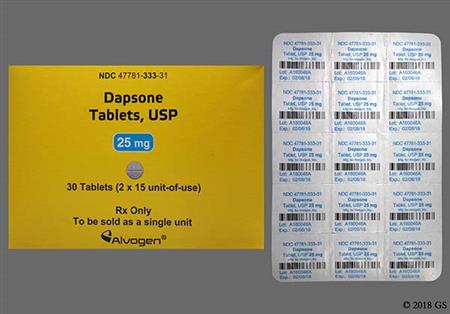
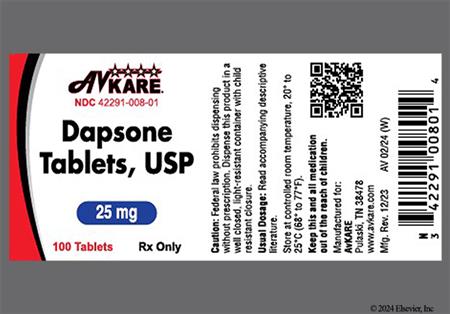
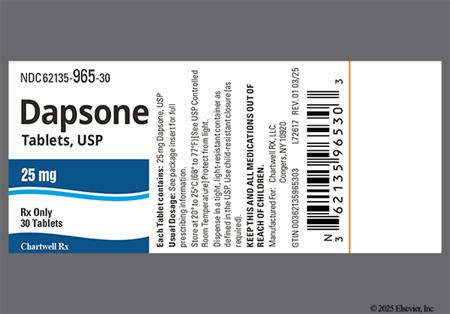
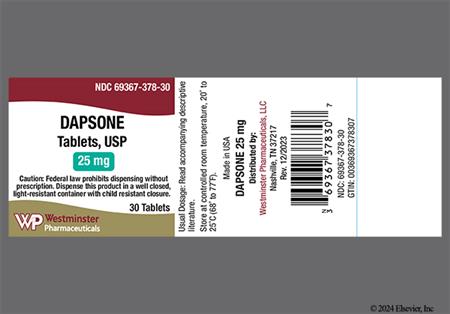
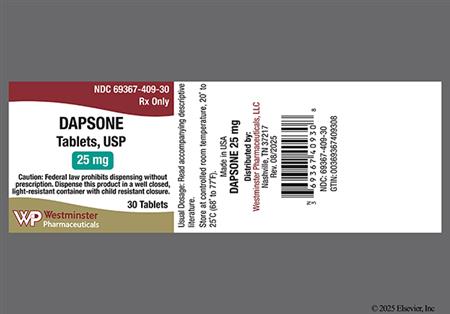
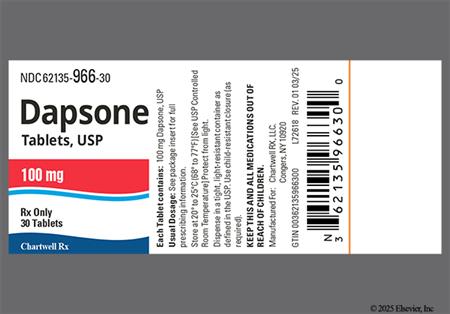
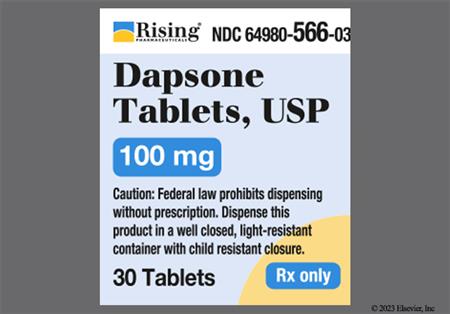

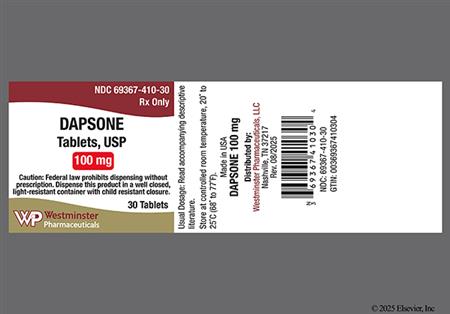
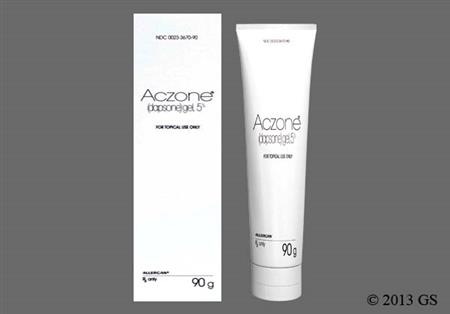

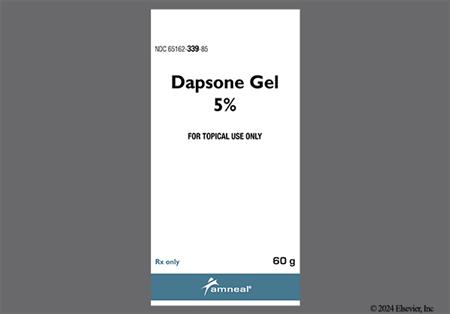
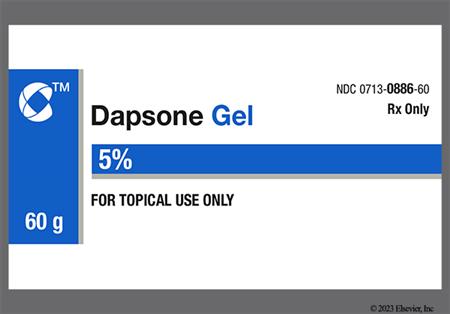
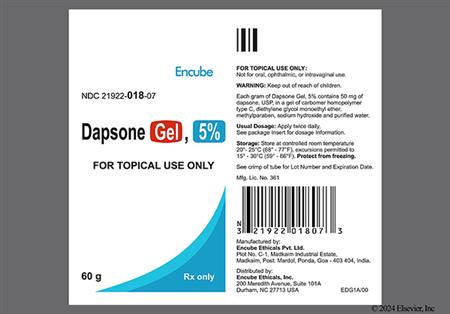
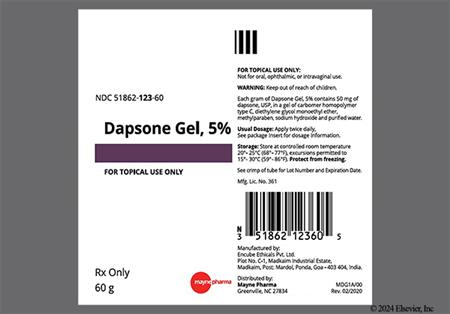
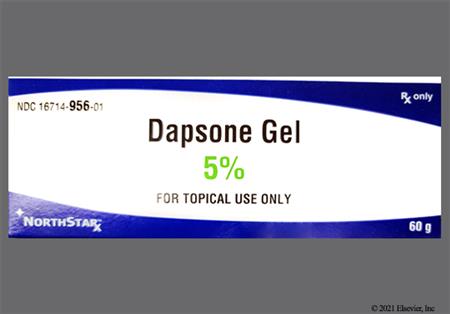
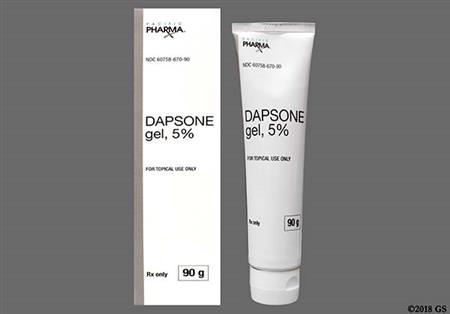
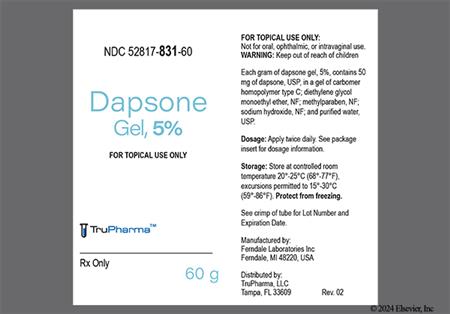
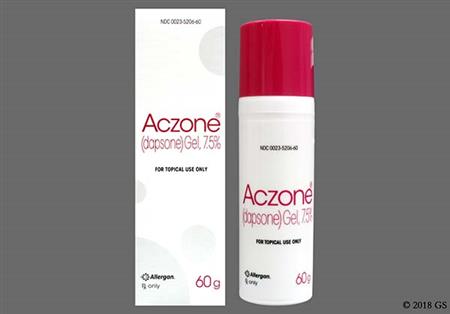

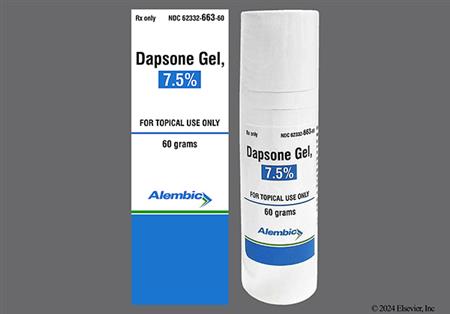
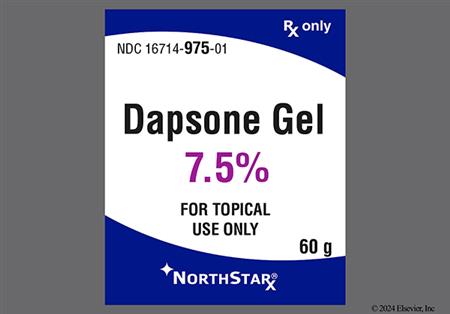
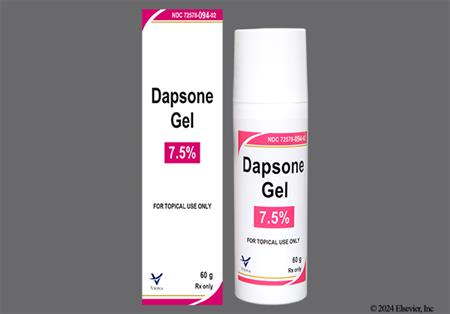
Dapsone is a versatile drug. It is a synthetic sulfone and is chemically similar to sulfonamides, but cross-sensitivity has not been substantiated. It is used as an antiinfective (for leprosy, Pneumocystis pneumonia (PCP), and prophylaxis of malaria) and as an immunosuppressive agent (for relapsing polychondritis and systemic lupus erythematosus). Dapsone also has been used to treat various dermatologic disorders such as actinomycotic mycetoma, dermatitis herpetiformis, pemphigoid, subcorneal pustular dermatosis, granuloma annulare, and pyoderma gangrenosum. In addition, dapsone is commonly used to treat Loxosceles reclusa (e.g., brown recluse spider) bites; however, both human and animal data to support its routine use are conflicting. A few case reports and small case series indicate efficacy in humans, but prospective human trials supporting its use are not available. Furthermore, in addition to the lack of evidence to support its use, dapsone can cause serious, life-threatening toxicities (e.g., hemolytic anemia, hepatitis, methemoglobinemia). A prospective epidemiologic study found that patients treated with dapsone for suspected loxoscelism experienced a nonsignificant increase in healing time and scarring.[32028] The benefits of administering dapsone for the treatment of loxoscelism should be carefully balanced against the risks; supportive therapy and wound care are the treatment modalities of choice in patients presenting with loxoscelism.[32027][32029] Dapsone is currently the agent of choice in the treatment of all forms of leprosy, unless the organism exhibits dapsone resistance. Dapsone can be used for prophylaxis of PCP either as a single agent or in combination with pyrimethamine. In combination with trimethoprim, dapsone is effective for treatment of PCP.[23640] In combination with pyrimethamine, dapsone is effective for prevention of toxoplasmosis in patients with AIDS.[23642] Acedapsone is a long-acting repository form. In Canada, a commonly used brand name of oral dapsone is Avlosulfon. Dapsone was originally approved by the FDA in 1955. A topical dapsone gel (Aczone) was approved in a 5% strength for the treatment of acne vulgaris in July 2005, and in a 7.5% strength in February 2016.[34470][60612]
For storage information, see the specific product information within the How Supplied section.
NOTE: Extemporaneously compounded oral dapsone suspension is not FDA-approved.
Extemporaneous preparation of 2 mg/mL dapsone oral suspension
Gel Formulation:
Dose-related hemolysis is the most common adverse effect reported with oral dapsone and is noted in persons with or without glucose 6-phosphate dehydrogenase (G6PD) deficiency. Almost all persons experience hemoglobin decreases of 1 to 2 g/dL, reticulocyte count increases of 2% to 12%, shortened red cell life span, and methemoglobinemia.[48574] Persons with G6PD deficiency, methemoglobin reductase deficiency, or hemoglobin M may experience more pronounced adverse hematologic effects, such as hemolytic anemia, Heinz body formation, and/or methemoglobinemia.[34470] [48574] [60612] Potentially fatal agranulocytosis, aplastic anemia, and other blood dyscrasias have been documented. Monitor blood counts frequently in persons receiving oral dapsone; when feasible, monitor blood counts weekly for the first month, monthly for 6 months, and then semi-annually thereafter. Discontinue dapsone for significant reductions in leukocytes, platelets, or hemopoiesis.[48574] Studies with topical dapsone have found no evidence of clinically significant hemolytic anemia; however, laboratory changes suggestive of hemolysis have been reported. Discontinue topical dapsone if signs or symptoms suggestive of hemolytic anemia occur.[34470] [60612]
Severe dermatologic reactions develop rarely during therapy with dapsone and are frequently the result of sensitization to the drug. Cutaneous effects that have been reported during oral therapy include bullous rash, exfoliative dermatitis, toxic erythema, erythema multiforme, morbilliform and scarlatiniform reactions, urticaria, toxic epidermal necrolysis, and erythema nodosum leprosum in patients being treated for leprosy. These reactions have not been observed during clinical trials with the topical formulation; however, rash (including erythematous rash) and swelling of the face (including lip and eye swelling) have been noted in postmarketing reports with the topical product. Photosensitivity has also been observed during oral dapsone therapy. Application site reactions have been reported with the use of topical dapsone and include unspecified reactions (18%), dryness or xerosis (up to 16%), erythema (13%), burning (1%), pruritus (1%), and oiliness or peeling (up to 13%).[48574] [34470] [60612]
Adverse gastrointestinal effects that can occur during therapy with oral dapsone include nausea, vomiting, and abdominal pain.[48574]
In rare cases, peripheral neuropathy has occurred in patients receiving oral dapsone for non-leprosy purposes. This complication, which is characterized by motor loss and muscle weakness, usually resolves following discontinuance of the drug. In leprosy patients, this complication may be difficult to distinguish from a leprosy reactional state. No cases of peripheral neuropathy were reported during clinical trials with topical dapsone.[48574] [34470]
Toxic hepatitis and cholestatic jaundice have occurred, particularly during the initial stages of therapy with oral dapsone. These complications can manifest as elevated hepatic enzymes, specifically elevations in alkaline phosphatase, SGOT, bilirubin, and LDH. Hyperbilirubinemia may occur more often in G6PD deficient patients.[48574]
Adverse renal effects observed during therapy with oral dapsone include albuminuria, nephrotic syndrome, and renal papillary necrosis.[48574]
Abrupt changes in the patient's clinical status during effective treatment with dapsone for leprosy can cause leprosy reactional states. These reactional states can be divided into two categories: reversal reactions (type I) and lepromatous lepra reactions (type II). Type I reactions occur primarily in borderline or tuberculoid leprosy patients. Patients can exhibit an enhanced delayed hypersensitivity reaction to the infection, which can manifest as swelling of the skin and nerve lesions, ulceration of lesions, acute neuritis, and loss of nerve function. Type II reactions occur primarily in patients with lepromatous or borderline leprosy. Approximately 50% of patients experience this complication within the first year of treatment. These reactions are the result of increased immune complexes on sensitized tissues. Primary manifestations include fever and erythematous skin lesions, sometimes in conjunction with joint swelling, epistaxis, neuritis, orchitis, albuminuria, malaise, iritis, or depression. Histologically, there is a vasculitis with an intense polymorphonuclear infiltrate. Fever has also been associated with 1% of patients receiving the topical gel.[48574] [34470]
Headache has been reported with the use of oral and topical (4%) dapsone. Insomnia and psychosis have been noted in patients treated with oral dapsone.[48574] [34470]
Nasopharyngitis (5%), unspecified upper respiratory tract infection (3%), sinusitis (2%), influenza (1%), pharyngitis (2%), and cough (2%) have been reported with the use of topical dapsone in clinical trials.[34470] An infectious mononucleosis-like syndrome has been reported with the use of oral dapsone.[48574]
Vertigo, blurred vision, and tinnitus have been reported with the use of oral dapsone.[48574]
Pancreatitis has been reported with the use of oral dapsone.[48574]
Pulmonary eosinophilia (eosinophilic pneumonia) and hypoalbuminemia without proteinuria have been reported with the use of oral dapsone.[48574]
Sinus tachycardia has been reported with the use of oral dapsone.[48574]
Male infertility has been reported with the use of oral dapsone.[48574]
A drug-induced Lupus erythematosus (lupus-like symptoms) has been reported with the use of oral dapsone.[48574]
Dapsone may cause laboratory test interference. Falsely reduced HbA1c measurements have been reported with dapsone. When discordance between HbA1c and blood glucose concentrations is observed or suspected, alternative measures of glycemic control, such as fructosamine or more frequent blood glucose monitoring, are recommended. Falsely reduced HbA1c may occur without overt hemolysis or anemia.[48574]
The coadministration of certain medications may lead to harm and require avoidance or therapy modification; review all drug interactions prior to concomitant use of other medications.
This medication is contraindicated in patients with a history of hypersensitivity to it or any of its components.[48574] Although the risk of cross-sensitivity is low, use dapsone, a synthetic sulfone, cautiously in individuals with sulfonamide hypersensitivity.[32380][32381][32382]
Uncontrolled studies of systemic dapsone use in pregnant women have not demonstrated fetal risk during any trimester of pregnancy nor did use affect reproduction capacity. Although further study is needed, it has been recommended by some authorities that dapsone therapy be maintained during pregnancy in cases of leprosy or dermatitis herpetiformis.[48574] Information on the use of topical dapsone in pregnant patients is not available; however, systemic exposure of the topical gel is low compared to oral dapsone administration (approximately 100 times less).[34470] [60612]
Perform testing for glucose-6-phosphate dehydrogenase (G6PD) deficiency prior to dapsone therapy.[34362] Use oral dapsone with caution in individuals with G6PD deficiency, methemoglobin reductase deficiency, or hemoglobin M disease because hemolysis, Heinz body formation, and/or methemoglobinemia may be exaggerated in individuals with these conditions.[34470] [48574] [60612] Additional guidance recommends avoiding oral dapsone in individuals with G6PD deficiency due to high risk of hemolytic anemia.[34362] [69163] Use oral dapsone with caution with other medications or conditions capable of inducing hemolysis, such as diabetic ketoacidosis or infection. Monitor blood counts frequently in individuals receiving oral dapsone; when feasible, monitor blood counts weekly for the first month, monthly for 6 months, and then semi-annually thereafter. Treat severe anemia prior to the initiation of oral dapsone and monitor hemoglobin. Hyperbilirubinemia may also occur more often in G6PD deficient individuals receiving oral dapsone. When possible, baseline and subsequent monitoring of liver function is recommended; if abnormal, discontinue oral dapsone until the source of the abnormality is established.[48574] Avoid topical dapsone in individuals with congenital or idiopathic methemoglobinemia.[34470] [60612]
Dapsone is distributed into breast milk in large quantities after oral dosing and can cause hemolytic anemia in nursing infants with G6PD deficiency.[48574] However, the American Academy of Pediatrics (AAP) states that dapsone is usually compatible with breast-feeding.[27500] Absorption after topical administration is minimal relative to oral dapsone administration.[34470] Consider the benefits of breast-feeding, the risk of potential infant drug exposure, and the risk of an untreated or inadequately treated condition. If a breast-feeding infant experiences an adverse effect related to a maternally administered drug, healthcare providers are encouraged to report the adverse effect to the FDA.
Similar to sulfonamides, dapsone inhibits dihyropteroate synthase in susceptible organisms. Other proposed mechanisms for dapsone include inhibition of the neutrophilic-cytotoxic system and interference with the alternate pathway of the complement system. Although the mechanism of dapsone in dermatologic disorders is unknown, it has been suggested that it may act as an immunomodulator.
For many years, dapsone was the main therapy for leprosy (Mycobacterium leprae). Unfortunately, years of monotherapy has lead to significant resistance in this organism. Resistance to M. leprae develops in 2—10% of patients after prolonged administration. Nevertheless, dapsone remains a component of combination therapy for leprosy.
Revision Date: 08/03/2025, 06:42:47 AMDapsone is administered orally or topically. It is widely distributed and is retained in the skin, muscles, kidneys, and liver. It also crosses the placenta and is distributed into breast milk.
Dapsone and its primary acetylated metabolite, monoacetyldapsone (MADDS), undergo enterohepatic recirculation. Acetylation is accomplished via N-acetyltransferase. Unlike with other acetylated compounds, slow and fast acetylators have exhibited no differences in pharmacokinetics, side effects, or therapeutic response. Minor metabolites include diacetyl derivatives and hydroxylamine dapsone (NOH-DDS). The latter metabolite appears to be associated with methemoglobinemia and hemolysis, which have been reported during therapy. The hydroxylamine metabolite is primarily produced by N-hydroxylation via CYP3A and CYP2C9 enzymes. The average half-life of both dapsone and MADDS is 30 hours. About 20% of a dose is excreted unchanged in the urine, while 70—85% is excreted as metabolites. A small amount can be detected in the feces.
Affected cytochrome P450 isoenzymes: CYP3A, CYP2C9
Dapsone is almost completely absorbed from the GI tract following oral administration. Peak serum levels are reached in 2—8 hours.
Following topical application, dapsone is absorbed into systemic circulation; however, systemic drug exposures are only 1% of those observed with the 100 mg oral dose. Steady state concentrations are achieved within 7 days of dosing.[34470][60612]
Uncontrolled studies of systemic dapsone use in pregnant women have not demonstrated fetal risk during any trimester of pregnancy nor did use affect reproduction capacity. Although further study is needed, it has been recommended by some authorities that dapsone therapy be maintained during pregnancy in cases of leprosy or dermatitis herpetiformis.[48574] Information on the use of topical dapsone in pregnant patients is not available; however, systemic exposure of the topical gel is low compared to oral dapsone administration (approximately 100 times less).[34470] [60612]
Dapsone is distributed into breast milk in large quantities after oral dosing and can cause hemolytic anemia in nursing infants with G6PD deficiency.[48574] However, the American Academy of Pediatrics (AAP) states that dapsone is usually compatible with breast-feeding.[27500] Absorption after topical administration is minimal relative to oral dapsone administration.[34470] Consider the benefits of breast-feeding, the risk of potential infant drug exposure, and the risk of an untreated or inadequately treated condition. If a breast-feeding infant experiences an adverse effect related to a maternally administered drug, healthcare providers are encouraged to report the adverse effect to the FDA.
Cookies are used by this site. To decline or learn more, visit our cookie notice.
Copyright © 2025 Elsevier, its licensors, and contributors. All rights are reserved, including those for text and data mining, AI training, and similar technologies.